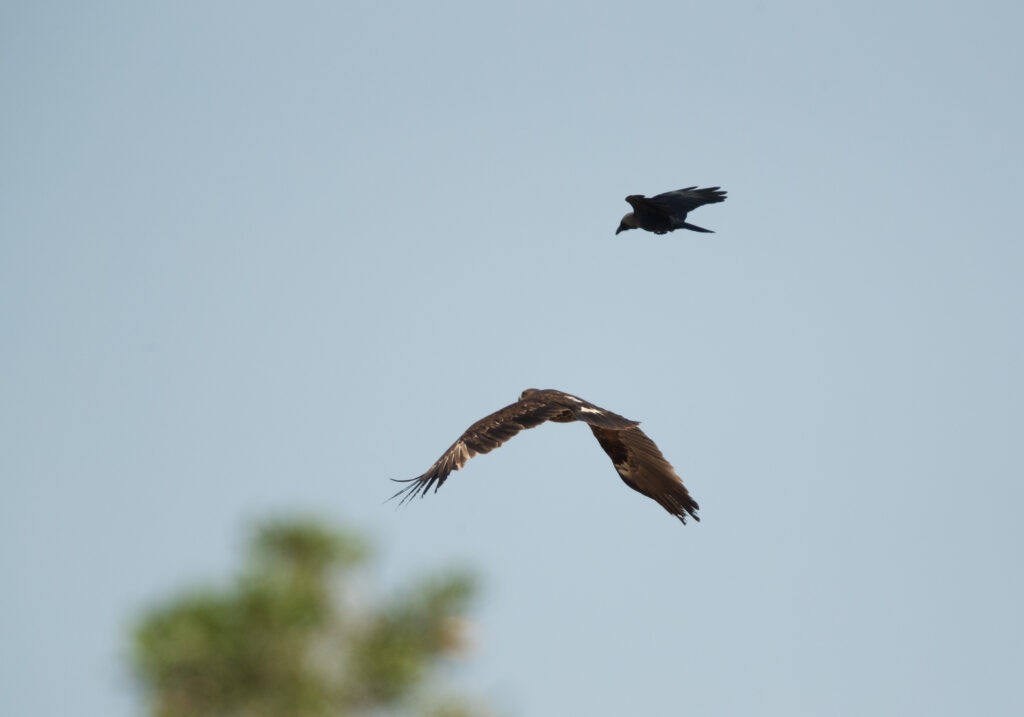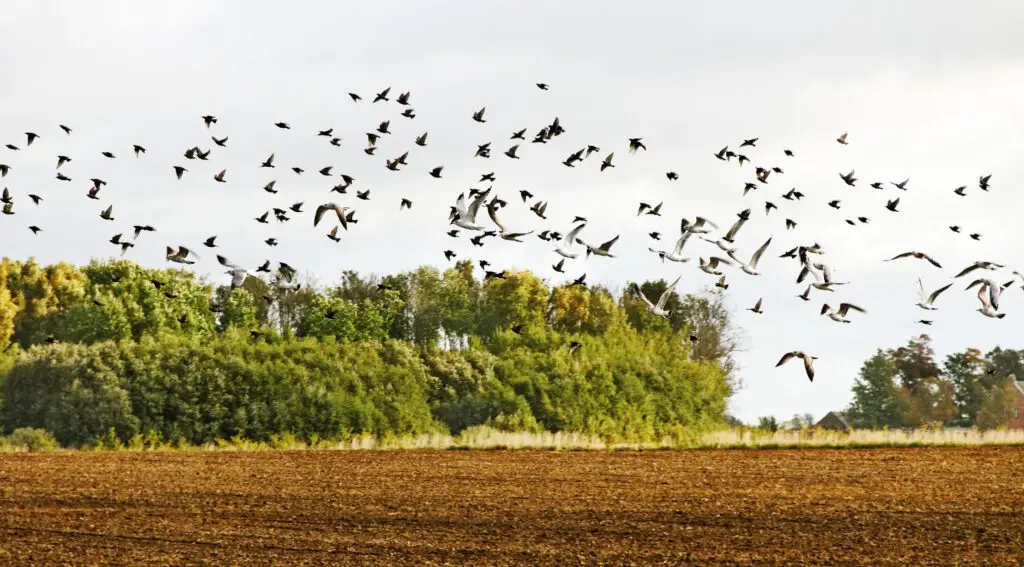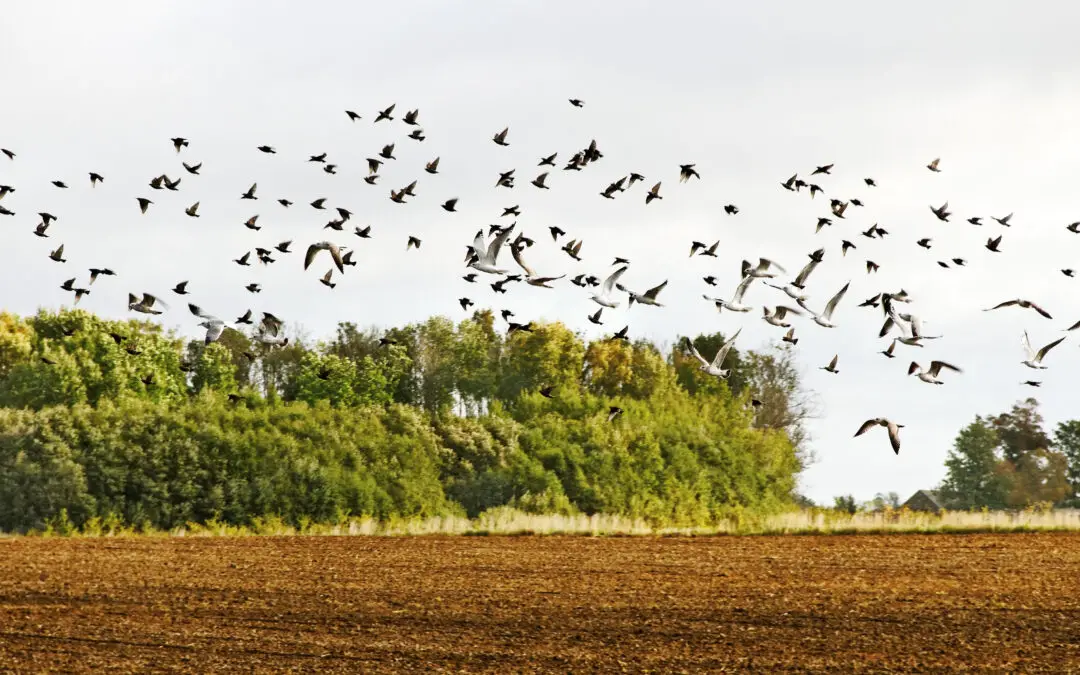Birds are known to exhibit a collective behavior called mobbing when confronted with larger predators. This behavior involves multiple individuals of the same or different species gathering together and actively harassing the predator.
The reasons behind this behavior have long intrigued researchers in the field of ornithology. This article aims to explore the various explanations for why birds engage in mobbing behavior towards larger predators.
The protection of nest and young, confusing and distracting the predator, sending warning signals to other birds, taking advantage of safety in numbers, asserting dominance and establishing territory, teaching and learning from each other, as well as evolutionary adaptations for survival are some potential factors that contribute to this phenomenon.
By examining these possible explanations, we can gain a better understanding of the ecological and evolutionary significance of bird mobbing behavior.

Protection of Nest and Young
The phenomenon of avian mobbing towards larger predators primarily serves as a strategic defense mechanism to protect their nests and vulnerable offspring. Parental defense is a crucial aspect of avian behavior, as birds invest significant time and energy into raising their young.
By engaging in mobbing behavior, birds are able to collectively deter potential threats through the power of numbers. This group defense strategy involves multiple individuals working together to harass, intimidate, or distract the predator.
The mobbing birds often exhibit alarm calls and aggressive behaviors, such as swooping and dive-bombing, aiming to drive away the intruder. The main objective is to create a hostile environment for the predator, ensuring that it perceives the area surrounding the nest as too risky to approach.
Through this cooperative effort, birds effectively safeguard their nests and enhance their chances of successfully rearing their offspring.
Confusing and Distracting the Predator
Confusing and distracting potential threats, smaller avian species engage in collective behavior to divert the attention of larger predatory animals. This strategy involves using mimicry techniques and creating decoy targets to confuse the predator and protect their nests and young. Birds achieve this by employing the following tactics:
- Alarm calls: By emitting loud vocalizations, birds alert their conspecifics about the presence of a predator, causing them to join in mobbing behavior.
- Mobbing flights: Birds rapidly fly around the predator, creating confusion with their erratic movements and making it difficult for the predator to focus on any single bird.
- Dive-bombing: Some bird species swoop down towards predators repeatedly, aiming to intimidate them or distract them from their intended target.
- Aggressive displays: Birds may puff up their feathers, spread their wings, or engage in threatening postures to discourage predators from approaching further.
By utilizing these tactics collectively, birds effectively confuse and distract larger predators, reducing the risk of predation on themselves and protecting their nestlings from harm.
Sending Warning Signals to Other Birds
Sending warning signals to conspecifics, smaller avian species utilize a variety of communication techniques to alert nearby birds about the presence of potential threats. Interspecies communication plays a crucial role in predator avoidance strategies among birds. By emitting specific vocalizations or alarm calls, they inform other birds in the vicinity about the potential danger and help coordinate group mobbing behaviors. This cooperative response not only confuses and distracts larger predators but also increases the chances of survival for individual birds within the flock. Additionally, some bird species engage in visual displays like wing-flashing or tail-raising to communicate danger signals effectively. These warning signals serve as an important means of maintaining group cohesion and facilitating collective defense against predators. Table 1 below provides examples of different types of warning signals used by various bird species.
Table 1: Examples of Warning Signals Used by Birds
| Species | Vocalizations | Visual Displays |
|---|---|---|
| Blue Jay | Loud screeches | Wing-flashing |
| Northern Cardinal | Sharp alarm calls | Tail-raising |
| European Starling | High-pitched whistles | Head-bobbing |
| Black-capped Chickadee | “Chick-a-dee-dee” call | Chest-puffing |
| American Robin | Repeated clucking sounds | Beak-pointing |
This table aims to evoke an emotional response from the audience by presenting a vivid description of how different bird species employ both vocal and visual warnings to ensure their safety and that of their fellow avian companions.
Taking Advantage of Safety in Numbers
Coordinated movement within a flock allows avian species to exploit the safety that comes from being part of a larger group. This behavior is especially evident when birds mob larger predators. By gathering together and acting as a unified force, birds are able to intimidate and potentially deter these threats.
The advantages of safety in numbers include increased vigilance, shared information, and reduced individual risk. In terms of predatory behavior, mobbing is an effective strategy for smaller birds to defend themselves against larger predators. Group dynamics play a crucial role in this phenomenon, as individuals synchronize their movements and vocalizations to create an intimidating display.
Overall, taking advantage of safety in numbers through coordinated mobbing helps birds increase their chances of survival when facing potential threats from larger predators.
Asserting Dominance and Establishing Territory
To establish dominance and secure their territory, avian species engage in assertive behaviors that serve to intimidate potential intruders. This behavior is crucial for maintaining social hierarchy within the bird community and ensuring survival.
Birds often form social groups where individuals have specific roles and ranks. Dominant birds use aggressive displays such as vocalization, wing flapping, or physical attacks to assert their authority over other members of the group and potential predators.
By asserting dominance, birds are able to maintain control over limited resources like food or nesting sites, which are essential for their survival. Additionally, establishing territory through assertive behaviors helps birds protect their offspring from potential threats and ensure the overall well-being of the group.
Overall, these survival tactics play a vital role in maintaining stability within avian communities.

Teaching and Learning from Each Other
Birds mob larger predators as a means of asserting dominance and establishing territory. However, this behavior also serves another purpose: teaching and learning from each other.
Birds engage in mobbing behavior to communicate with their fellow flock members about potential threats and to coordinate their actions. They use various communication methods such as vocalizations, body postures, and visual displays to convey information about the presence of a predator and the level of danger it poses.
By engaging in mobbing, birds not only alert others to the presence of a predator but also pass on valuable knowledge about how to effectively deal with the threat. This social behavior allows for collective learning within bird communities, ensuring that future generations are equipped with the necessary skills and strategies to protect themselves against larger predators.
Evolutionary Adaptations for Survival
Evolutionary adaptations for survival include the development of specialized physical characteristics and behavioral strategies that enable organisms to effectively defend themselves against potential threats. In the case of birds mobbing larger predators, this behavior can be seen as an evolutionary advantage. Mobbing is a cooperative defense strategy employed by certain bird species where multiple individuals gather to harass and drive away predators. This behavior not only serves to protect the individuals involved but also benefits the entire group by reducing predation risk.
Birds have evolved various physical adaptations that aid in mobbing larger predators. For example, some species have developed sharp beaks and strong talons that they use to peck or claw at predators. Additionally, many birds possess highly agile flight capabilities, allowing them to swiftly maneuver around their target and make it difficult for the predators to catch them.
In terms of behavioral strategies, mobbing allows birds to exploit predator-prey dynamics. By forming a large group and collectively attacking a predator, birds increase their chances of driving it away or distracting it long enough for other members of their group or nearby individuals to escape. Furthermore, mobbing can serve as an alarm call system, alerting other potential prey species in the area about the presence of a predator.
| Physical Adaptations | Behavioral Strategies | Predator Prey Dynamics |
|---|---|---|
| Sharp beaks | Forming large groups | Increasing chances |
| Strong talons | Collectively attacking | Distracting predators |
| Agile flight | Alarm call system | Alerting prey species |
Overall, through evolutionary advantages such as specialized physical characteristics and coordinated behavioral strategies like mobbing larger predators, birds have developed effective ways to survive and defend themselves against potential threats. These adaptations not only protect individual birds but also contribute to their overall fitness within their respective ecosystems.


